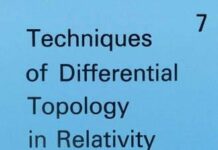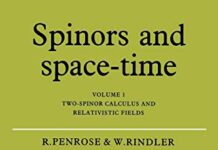
Ebook Info
- Published: 1988
- Number of pages: 512 pages
- Format: PDF
- File Size: 38.10 MB
- Authors: Roger Penrose
Description
Spinor and Twistor Methods in Space-Time Geometry introduces the theory of twistors, and studies in detail how the theory of twistors and 2-spinors can be applied to the study of space-time. Twistors have, in recent years, attracted increasing attention as a mathematical tool and as a means of gaining new insights into the structure of physical laws. This volume also includes a comprehensive treatment of the conformal approach to space-time infinity with results on general-relativistic mass and angular momentum, a detailed spinorial classification of the full space-time curvature tensor, and an account of the geometry of null geodesics.
User’s Reviews
Editorial Reviews: Review “Topics covered include massless fields, the geometry of light rays, and the conformal structure of infinity. Twistorial applications abound and are presented in great detail. The approach here is to show how problems with the standard physical framework may be solved using new twistorial techniques.” American Mathematics Monthly
Reviews from Amazon users which were colected at the time this book was published on the website:
⭐It is the second volume of Penrose and Rindler`s book on Spinors and Twistors. I was interested in this book since I read the book of E.Cartan on Spinors and the papers on application of the spinor theory to the field theory by Atiyah et al., and wanted to learn the twistor idea invented by Penrose.In the beginning, useful formulae derived in the first volume are summarized.For physicists who want to learn the idea first but not the rigorous proofs, it is helpful. The triality symmetry of octonion, which is fully discussed in Cartan’s book is discussed briefly in the appendix. Since the notation of the Dirac spinor is not used in the book, it is not straightforward to interpret the formulae in the language of the field theory, but it contains helpful ideas for understanding symmetries of the universe.
⭐The first volume of this set provided a through development of two-spinor calculus. This book, the second volume, uses two-spinor calculus to analyze some problems in physics. It examines situations where spinor methods unquestionably provide value, such as Witten’s proof of the positive energy theorem. It also introduces twistors (only briefly mentioned in volume I). The original goal of twistor theory was very ambitious, to essentially quantize space-time by making it a concept derived from twistor space. Obviously that hasn’t be achieved, but that goal isn’t a primary focus of this book.The first chapter is a quick recap of volume I, including most of the formulas from it that are used in this book. After this, twistors are introduced. The algebra is easy to follow, but there is a lot of it. A geometric description of null twistors is given in terms of the spinors it’s composed of. Later it’s shown how to construct a null twistor, up to a phase factor, from the momentum and spin of a massless particle. I thought this provided a nice physical model. One of the interesting things is that conformal invariance has a fairly central role, as it does in string theory. Overall the contact with physics in this chapter is fairly light.From this point on application to physics are more central, of course there is still plenty of math. The first topic considered is congruences of null geodesics. A couple of things stand out. One is the coverage is more complete than usual. The other is that the authors describe the relation of twistors to shear free ray congrucences, normally it’s only spinors that are used to describe the congruences.The next chapter covers on of the more widely used applications of spinor methods to general relativity, the classification of the Weyl tensor. While this is perhaps the most widely discussed application of spinors in general relativity, the depth of the discussion here is much greater than the usual. Instead of just showing how much more transparent the analysis is with spinors, this book also adds a twist that cannot be done with tensors, it considers changing the phase and magnitude of the Weyl spinor, i.e. it considers more than the principal null directions. There is also material on the classification of the Ricci curvature, which is uncommon.Following this spinors are applied to asymptotic questions in general relativity. The chapter begins with a review of causal structure and compactification (compactification in the sense of conformal compactification, not in the sense of wrapping extra dimensions in a small torus). The view that space-time points are entities derived from twistor space is further developed here, but still not in great detail. For me the best parts of this, rather long, chapter were the discussions of peeling properties of gravitational radiation the use of spinors and twistors to analyze energy-momentum and angular momentum. Regarding the latter, it also includes the use of spinors to prove the positive energy theorem.I liked this book a lot, even more than volume I. One thing that surprised me is that I expected more development of twistor theory, there was a fair amount, but I would have liked to have seen more. A lot of the material in this book is clearly relevant to physics, however there is also a substantial amount that is more speculative.
⭐I purchased Spinors and space-time volume 2 after hearing Sir Roger Penrose give a lecture on the 2-part series. Here is my general impression of the book after reading portions of it this afternoon. The book is in excellent condition, and I am very pleased with my purchase.The illustrations and explanations are exquisite. I appreciate the precise terminology and generalizations to algebraic structures beyond just vectors. The reader does not have to take the authors at their word and can instead see the reasoning leading to an idea. Concepts such as sheaves are mentioned in passing if they are of interest to a knowledgeable reader but not essential to someone just trying to pick up the basics. These fun facts are interspersed throughout the book without making the text too dense. Every essential idea appears to be explained with the non-expert in mind. The tone of the book is inviting and enthusiastic.This book is an heirloom physics text which is a delight to behold. The color of the dust jacket is sphene-green, which is fitting, because sphenes are one of most sparkly and rarest of gems.
⭐
⭐
Keywords
Free Download Spinors and Space-Time: Volume 2, Spinor and Twistor Methods in Space-Time Geometry (Cambridge Monographs on Mathematical Physics) in PDF format
Spinors and Space-Time: Volume 2, Spinor and Twistor Methods in Space-Time Geometry (Cambridge Monographs on Mathematical Physics) PDF Free Download
Download Spinors and Space-Time: Volume 2, Spinor and Twistor Methods in Space-Time Geometry (Cambridge Monographs on Mathematical Physics) 1988 PDF Free
Spinors and Space-Time: Volume 2, Spinor and Twistor Methods in Space-Time Geometry (Cambridge Monographs on Mathematical Physics) 1988 PDF Free Download
Download Spinors and Space-Time: Volume 2, Spinor and Twistor Methods in Space-Time Geometry (Cambridge Monographs on Mathematical Physics) PDF
Free Download Ebook Spinors and Space-Time: Volume 2, Spinor and Twistor Methods in Space-Time Geometry (Cambridge Monographs on Mathematical Physics)




